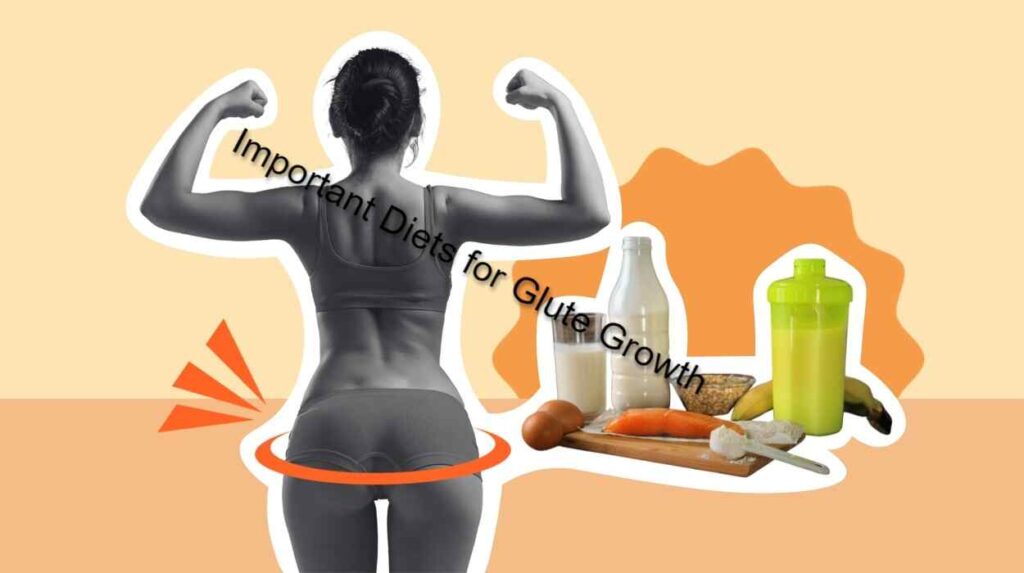Proper nutrition is a cornerstone when it comes to building muscle and reshaping one’s physique, particularly regarding glute growth. The glutes are some of the largest and most powerful muscles in the body, and supplying them with the right fuel is essential for stimulating growth and recovery after workouts.
Consuming adequate calories from quality protein, complex carbohydrates, and healthy fats can make the difference between suboptimal results and achieving a stronger, more defined lower body.

Understanding the Term How Many Calories to Grow Glutes
Understanding ‘How Many Calories to Grow Glutes’ involves calculating the calorie surplus needed for muscle growth specifically in the glute area. It’s about balancing nutritional intake to fuel workouts and recovery from glute enlargement. This concept guides individuals on their journey to achieve stronger, more defined glutes through diet and exercise.
A. Explaining the concept of caloric surplus for muscle growth
To achieve hypertrophy in the gluteal muscles, it is imperative to understand and apply the principle of caloric surplus. A caloric surplus occurs when one consumes more calories than the body spends.
This surplus provides the body with the additional energy required to repair and grow muscle fibers after intensive training. A strategic approach to caloric intake, combined with resistance training geared towards glute development, creates an optimal environment for muscle growth.
B. Factors influencing caloric requirements specific to glute development
The caloric requirements for glute growth are influenced by several factors, including an individual’s basal metabolic rate (BMR), level of physical activity, and the intensity of glute-focused workouts.
Additionally, each person’s body composition, metabolism, and genetic factors play a significant role in determining the ideal caloric surplus for muscle growth.
C. Addressing common misconceptions about calorie intake and glute growth
One common misconception is that calories from any source can contribute to muscle growth. In reality, it’s crucial to focus on nutrient-dense calories that support the body’s needs for growth and recovery.
Equally important is the debunking of the myth that high-calorie intake will uniformly lead to muscle growth, regardless of food quality or exercise regimen. Understanding that caloric intake must be paired with appropriate strength training exercises is key to achieving targeted glute growth without excessive fat gain.
Determining Optimal Caloric Intake
A. Calculating basal metabolic rate (BMR) and total daily energy expenditure (TDEE)
Establishing the number of calories to consume for glute growth begins with the calculation of one’s Basal Metabolic Rate (BMR), the number of calories required to maintain basic physiological functions at rest. Various formulas exist to estimate BMR, such as the Harris-Benedict equation, which considers age, sex, weight, and height.
To tailor this to an active lifestyle, BMR is then factored into the Total Daily Energy Expenditure (TDEE), which incorporates all daily activities and exercises. TDEE gives a more comprehensive view of caloric needs, forming the foundation for crafting a caloric surplus that promotes glute growth.
B. Tailoring caloric intake to individual body composition and activity level
It’s crucial to adapt caloric intake to one’s unique body composition and level of physical activity. Individuals with leaner builds and higher activity levels may require a greater caloric surplus to see noticeable changes in muscle size.
Conversely, those with a slower metabolism or lower activity level may need a modest surplus to grow the glutes efficiently, avoiding unnecessary fat accumulation. Tailoring the diet in this manner ensures that the surplus caters specifically to muscle development rather than weight gain.
C. Highlighting the role of micronutrients in supporting glute development
Macronutrients – carbohydrates, proteins, and fats – each play a specific role in supporting glute muscle development. Proteins are the building blocks of muscle and are essential for repair and growth post-workout. Carbohydrates fuel training and help replenish glycogen stores, while fats are vital for hormone regulation, including those involved in muscle growth.
An optimal balance of these macronutrients is paramount; it’s not just the quantity of calories that matters, but the quality and the ratio in which they’re consumed that supports effective glute development.

Diets That are Crucial for Glute Growth
Based on the search results, here are some diets that are important for glute growth:
- Protein Shake
- Protein shakes provide a convenient and quick source of high-quality protein, supporting muscle repair and growth, essential for developing glute muscles.
- Chia Seeds
- Chia seeds are rich in protein, fiber, and healthy fats, aiding in muscle recovery and providing sustained energy levels for effective workouts.
- Fish
- Fish such as salmon is a great source of lean protein and healthy fats, supporting muscle growth and overall body function, contributing to optimal glute development.
- Spinach
- Spinach is a nutrient-dense leafy green vegetable that provides essential vitamins and minerals, supporting overall nutrition for glute growth.
- Avocados
- Avocados are a source of healthy fats and essential nutrients, contributing to an optimal environment for muscle growth, including glute muscles.
- Lean Ground Beef
- Lean ground beef is a protein-rich food that supports muscle repair and growth, aiding in the development of glute muscles.
- Cottage Cheese
- Cottage cheese is a good source of protein and calcium, beneficial for muscle recovery and general fitness, including glute growth.
- Meat Steak
- Meat steak provides a substantial amount of high-quality protein and essential nutrients, supporting muscle growth and recovery, vital for glute development.
By incorporating these foods into one’s diet, individuals can support the nutritional requirements for glute growth and overall fitness goals.

Calorie Needs and Exercise Recommendations
Growing glutes effectively requires a combination of resistance training and an appropriate caloric surplus to support muscle growth. Here’s a foundational guide of calorie needs and specific exercises for different age groups.
| Age Group | Daily Calorie Surplus (Estimate) | Recommended Exercises |
|---|---|---|
| 18-25 | 2,200-2,500 kcal | Squats, Deadlifts, Hip Thrusts, Lunges |
| 26-35 | 2,000-2,300 kcal | Bulgarian Split Squats, Step-Ups, Glute Bridges, Band Walks |
| 36-45 | 1,800-2,100 kcal | Single-Leg Deadlifts, Kickbacks, Pelvic Lifts, Cable Pull-Throughs |
| 46-55 | 1,700-2,000 kcal | Romanian Deadlifts, Squat Pulses, Elevated Glute Bridges, Stability Ball Hamstring Curls |
| 55+ | 1,600-1,900 kcal | Low-Impact Squats, Resistance Band Side Leg Lifts, Pilates, Water Aerobics |
Monitoring Progress and Adjusting Caloric Intake
A. Tracking glute growth progress through measurements and visual cues
Properly monitoring progress is necessary for assessing the effectiveness of any nutrition and workout regimen aimed at glute growth. This can be done by regularly taking measurements of the hips and glutes with a tape measure to monitor size increases.
Alongside numerical data, visual cues such as the fit of clothing and comparison of progress photos over time can offer tangible evidence of development. These methods provide insight into whether the current caloric surplus is conducive to the targeted muscle growth or if adjustments are needed.
B. Strategies for assessing the effectiveness of caloric intake on glute development
| Strategy | Description |
|---|---|
| Tracking Caloric Intake | Use a food diary or app to monitor daily caloric intake, focusing on macronutrient distribution. |
| Body Measurements | Regularly measure glute size and shape to track changes over time, potentially using hip circumference. |
| Strength Progression | Monitor strength gains in glute-focused exercises like squats, deadlifts, and hip thrusts. |
| Energy Levels and Recovery | Assess energy levels and post-workout recovery to gauge the impact of caloric intake on muscle development. |
| Body Composition Analysis | Utilize methods like DEXA scans or bioelectrical impedance analysis to track changes in muscle mass and fat. |
| Performance in Workouts | Evaluate performance and endurance during glute-targeting workouts to determine the impact of caloric intake. |
| Consultation with a Nutritionist or Trainer | Seek professional guidance to analyze the relationship between caloric intake and glute development. |
C. Guidelines for making adjustments to caloric intake based on progress
If progress stalls or the rate of fat gain exceeds that of muscle growth, it may be necessary to adjust caloric intake. A slight reduction in daily calories, particularly from dietary fats or refined carbohydrates, could be implemented while observing the body’s response over subsequent weeks.
Conversely, if muscle gains are not apparent, a moderate increase in calories, with an emphasis on protein and complex carbohydrates, might be warranted. The key lies in small, incremental changes and consistent monitoring to ensure a tailored approach that aligns with individual goals for glute development.

Nutritional Strategies for Maximizing Glute Development
When it comes to maximizing glute development, paying attention to nutritional strategies is crucial. Let’s delve into the key aspects that can support your journey towards achieving optimal glute growth.
A. Highlighting Nutrient-Dense Foods to Support Glute Muscle Growth
Incorporating nutrient-dense foods into your diet can significantly contribute to supporting glute muscle growth. Foods rich in protein, such as lean meats, fish, eggs, and legumes, play a vital role in providing the necessary building blocks for muscle development.
Additionally, including leafy greens, colorful vegetables, and healthy fats can further enhance the overall nutritional value of your meals, promoting the growth and recovery of glute muscles.
B. Discussing the Importance of a Well-Balanced Diet in Achieving Optimal Glute Growth
A well-balanced diet forms the cornerstone of achieving optimal glute growth. Balancing macronutrients such as carbohydrates, proteins, and fats, along with essential micronutrients, ensures that your body has the necessary resources to support muscle development.
Moreover, maintaining a balanced diet can optimize energy levels, improve recovery, and sustain overall health, all of which are pivotal in facilitating the growth of glute muscles.
C. Emphasizing the Significance of Consistent and Sustained Caloric Intake for Long-Term Glute Development Success
Consistent and sustained caloric intake is a key driver for long-term glute development success. Whether aiming for muscle gain or fat loss, maintaining a consistent caloric intake aligned with your goals can foster a conducive environment for sustainable glute growth.
Striking the right balance between caloric intake, physical activity, and rest is fundamental in ensuring steady progress toward your desired glute development objectives.
Frequent Question Answers
By addressing the following frequently asked questions, we hope to provide clarity and guidance on how many calories to grow glutes.
| Question | Answer |
|---|---|
| Can I still grow my glutes in a calorie deficit? | Yes, it is possible to build glute muscles in a calorie deficit by focusing on high-protein intake, targeted resistance training, and ensuring overall nutrient adequacy. However, the rate of growth may be slower compared to being in a caloric surplus. |
| Will my glutes grow if I eat more? | Consuming a sufficient amount of calories, particularly from nutrient-dense sources, can provide the energy and resources needed for glute muscle growth. Pairing this with effective resistance training can optimize the potential for glute development. |
| How long does it realistically take to grow glutes? | The timeline for noticeable glute growth varies among individuals and depends on factors such as genetics, diet, training intensity, and consistency. Generally, significant changes may be observed over several months to a year of dedicated training and nutrition. |
| Do you need weight to grow glutes? | While resistance training with weights can effectively stimulate glute growth, bodyweight exercises and other forms of resistance, such as resistance bands, can also contribute to strengthening and shaping the glute muscles. |
| Can you build glutes with 20kg? | Using a 20kg weight, along with proper form and targeted exercises, can certainly contribute to glute development. It’s essential to progressively challenge the muscles, ensuring a balanced approach to training and recovery. |
| How to increase butt size? | Increasing butt size involves a combination of targeted glute exercises, adequate nutrition to support muscle growth, and an overall focus on lower body strength and hypertrophy. Consistency in training and patience are key in achieving desired results. |
| Will 50 squats a day make my bum bigger? | Incorporating 50 squats a day can contribute to strengthening and toning the glute muscles, but significant muscle growth may require additional resistance training and varied exercises targeting the glutes from different angles. |
| Are glutes the hardest muscle to grow? | Glute development can be challenging due to its composition and the need for specific activation, but with targeted training, proper nutrition, and consistency, significant glute growth is achievable over time. |
| Do glutes grow on rest days? | Glute muscles undergo repair and growth during rest days, especially when supported by adequate nutrition and recovery. It’s important to allow for proper rest and recovery to optimize the results of training efforts. |
Also Read: Top 10 Best Proteins to Grow Glutes in 2023-24
Conclusion
In conclusion, to effectively promote glute growth, it is advisable to maintain a modest calorie surplus of approximately 200-400 calories above maintenance levels. This surplus serves as the additional energy required to facilitate muscle development, including the glutes. Furthermore, a targeted approach to nutrition involves ensuring a daily protein intake within the range of 1.6 to 2.2 grams per kilogram of body weight. This protein level is crucial for providing the necessary building blocks for muscle repair and growth, thus supporting the development of larger and stronger glute muscles over time. By strategically incorporating this calorie surplus and protein intake, individuals can optimize their nutritional approach to align to enhance glute size and strength.
Sources
- Can Food Increase Your Body Mass? on Al Jazeera News Today
- The 5 Best Glute Exercises for Mass on Robor Fitness
- Glutes and Hamstrings Workout, Fire Up the Backside on Robor Fitness
- The 10 Best Exercises for a Bigger Butt on Robor Fitness






Leave a Reply